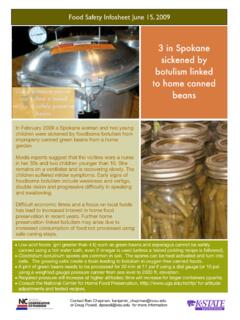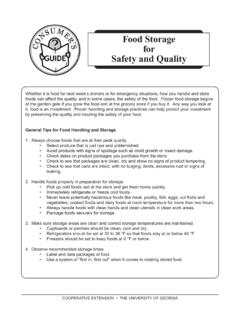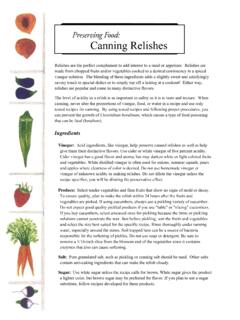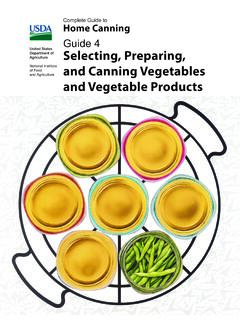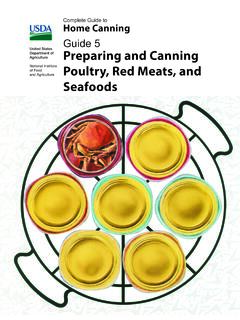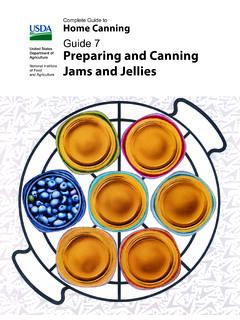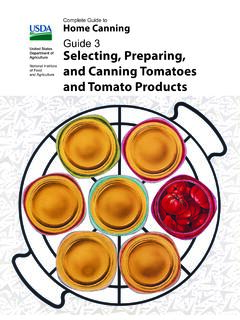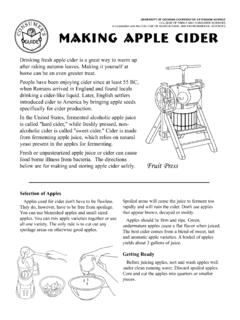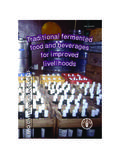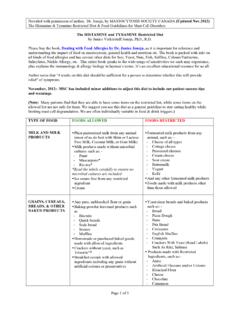Transcription of Guide 6 Preparing and Canning Fermented Foods and Pickled ...
1 Complete Guide to Home Canning Guide 6. Preparing and Canning Fermented Foods and Pickled Vegetables 6-2. Guide 6. Preparing and Canning Fermented Foods and Pickled Vegetables Table of Contents Selection of fresh 6-5. Low-temperature pasteurization 6-5. Suitable containers, covers, and weights for fermenting 6-6. Salts used in 6-7. Fermented Dill 6-7. 6-8. Cucumber Bread-and-butter 6-9. Quick fresh-pack dill Sweet gherkin 14-day sweet Quick sweet Other Vegetable Pickled 6. Pickled dilled Pickled three-bean Fermented Foods and Pickled Vegetables Pickled Pickled Pickled baby Pickled cauliflower or Brussels Chayote and jicama Bread-and-butter Pickled Marinated whole Pickled dilled Pickled pearl Marinated Pickled bell Pickled hot Pickled jalape o pepper Pickled yellow pepper Pickled sweet green Pickled mixed Pickled bread-and-butter 6-3.
2 Pickled Vegetable Chayote and pear Pickle Pickled corn Pickled green tomato Pickled horseradish Pickled pepper-onion Spicy jicama Tangy tomatillo Pickled Foods for Special No sugar added Pickled No sugar added sweet pickle cucumber Reduced-sodium sliced dill Reduced-sodium sliced sweet 6-4. Selection of fresh cucumbers Quantity: An average of 14 pounds is needed per canner load of 7 quarts; an average of 9 pounds is needed per canner load of 9 pints. A bushel weighs 48 pounds and yields 16 to 24 quarts an average of 2 pounds per quart. Quality: Select firm cucumbers of the appropriate size: about 1-1/2 inches for gherkins and 4 inches for dills. Use odd-shaped and more mature cucumbers for relishes and bread-and-butter style pickles. Low-temperature pasteurization treatment The following treatment results in a better product texture but must be carefully managed to avoid possible spoilage.
3 Place jars in a canner filled half way with warm (120 to 140 F) water. Then, add hot water to a level 1 inch above jars. Heat the water enough to maintain 180 to 185 F. water temperature for 30 minutes. Check with a candy or jelly thermometer to be certain that the water temperature is at least 180 F during the entire 30 minutes. Temperatures higher than 185 F. may cause unnecessary softening of pickles. Caution: Use only when recipe indicates. 6. Fermented Foods and Pickled Vegetables 6-5. Suitable containers, covers, and weights for fermenting food A 1-gallon container is needed for each 5 pounds of fresh vegetables. Therefore, a 5-gallon stone crock is of ideal size for fermenting about 25 pounds of fresh cabbage or cucumbers. food -grade plastic and glass containers are excellent substitutes for stone crocks.
4 Other 1- to 3-gallon non- food -grade plastic containers may be used if lined inside with a clean food -grade plastic bag. Caution: Be certain that Foods contact only food -grade plastics. Do not use garbage bags or trash liners. Fermenting sauerkraut in quart and half-gallon Mason jars is an acceptable practice, but may result in more spoilage losses. Cabbage and cucumbers must be kept 1 to 2 inches under brine while fermenting. After adding prepared vegetables and brine, insert a suitably sized dinner plate or glass pie plate inside the fermentation container. The plate must be slightly smaller than the container opening, yet large enough to cover most of the shredded cabbage or cucumbers. To keep the plate under the brine, weight it down with 2 to 3 sealed quart jars filled with water.
5 Covering the container opening with a clean, heavy bath towel helps to prevent contamination from insects and molds while the vegetables are fermenting. Fine quality Fermented vegetables are also obtained when the plate is weighted down with a very large clean, plastic bag filled with 3 quarts of water containing 6-6. 4-1/2 tablespoons of Canning or pickling salt. Be sure to seal the plastic bag. Freezer bags sold for packaging turkeys are suitable for use with 5-gallon containers. The fermentation container, plate, and jars must be washed in hot sudsy water, and rinsed well with very hot water before use. Salts used in pickling Use of Canning or pickling salt is recommended. Fermented and nonfermented pickles may be safely made using either iodized or noniodized table salt.
6 However, noncaking materials added to table salts may make the brine cloudy. Flake salt varies in density and is not recommended for use. Reduced-sodium salts, for example mixtures of sodium and potassium chloride, may be used in quick pickle recipes, as indicated in this Guide . The pickles may, however, have a slightly different taste than expected. Caution: Use of reduced-sodium salt in Fermented pickle recipes is not recommended. Fermented Foods DILL PICKLES. Use the following quantities for each gallon capacity of your container. 4 lbs of 4-inch pickling cucumbers 6. 2 tbsp dill seed or 4 to 5 heads fresh or dry dill weed 1/2 cup salt Fermented Foods and Pickled Vegetables 1/4 cup vinegar (5%). 8 cups water and one or more of the following ingredients: 2 cloves garlic (optional).
7 2 dried red peppers (optional). 2 tsp whole mixed pickling spices (optional). Procedure: Wash cucumbers. Cut 1/16-inch slice off blossom end and discard. Leave 1/4-inch of stem attached. Place half of dill and spices on bottom of a clean, suitable container (see page 6-6). Add cucumbers, remaining dill, and spices. Dissolve salt in vinegar and water and pour over cucumbers. Add suitable cover and weight. Store where temperature is between 70 and 75 F for about 3 to 4 weeks while fermenting. Temperatures of 55 to 65 F are acceptable, but the fermen- tation will take 5 to 6 weeks. Avoid temperatures above 80 F, or pickles will become too soft during fermentation. Fermenting pickles cure slowly. Check the container several times a week and promptly remove surface scum or mold.
8 Caution: If the pickles become soft, slimy, or develop a disagreeable odor, discard them. Fully Fermented pickles may be stored in the original container for about 4 to 6 months, provided they are refrigerated and surface scum and molds are removed regularly. Canning fully Fermented pickles is a better way to store them. To can them, pour the brine into a pan, heat slowly to a boil, and simmer 5 minutes. Filter brine through paper coffee filters to reduce cloudiness, if desired. Fill hot jar with pickles and hot brine, leaving 1/2-inch headspace. Remove air bubbles and adjust headspace if needed. Wipe rims of jars with a dampened clean paper towel. Adjust lids and process as below, or use the low temperature pasteurization treatment described on page 6-5. 6-7.
9 Recommended process time for Dill Pickles in a boiling-water canner Process Time at Altitudes of Style Jar 0 1,001 Above of Pack Size 1,000 ft 6,000 ft 6,000 ft Raw Pints 10 min 15 20. Quarts 15 20 25. SAUERKRAUT. 25 lbs cabbage 3/4 cup Canning or pickling salt Sauerkraut Quality: For the best sauerkraut, use firm heads of fresh cabbage. Shred cabbage and start kraut between 24 and 48 hours after harvest. Yield: About 9 quarts Procedure: Work with about 5 pounds of cabbage at a time. Discard outer leaves. Rinse heads under cold running water and drain. Cut heads in quarters and remove cores. Shred or slice to a Recommended process time for Sauerkraut in a boiling-water canner thickness of a quarter. Put cabbage in a suitable fermentation container (see page 6-6), and add Process Time at Altitudes of 3 tablespoons Style of salt.
10 Mix Jar thoroughly, 0 using clean 1,001 ,001 . Pack firmlyAbove until salt draws juices from cabbage. of Pack Repeat shredding, Size salting, and packing 1,000 ft until all6,000 ft 3,000 ft cabbage is6,000 ft in the container. Be sure it is deep enough Hot so thatPints its rim is at10 min least 4 or 515inches above15 the cabbage. 20 If juice does not cover cabbage, add boiled and cooled brine Quarts 15 (1-1/2 tablespoons 20 20of salt per 25. quart of water). Add plate and weights; cover Raw container with a clean Pints 20 bath towel. 25 Store at 3070 to 75 F 35while fermenting. At tem- peratures between 70 Quarts and 75 F, kraut 25 will be30. fully Fermented 35 in about 40 3 to 4 weeks; at 60 to 65 F, fermentation may take 5 to 6 weeks. At temperatures lower than 60 F, kraut may not ferment.


